REBLOG! The 25 Best Nike ACG Models of All Time by Gary Warnett

Gary Warnett has compiled a list of his 25 favourite silhouettes from Nike’s All Conditions Gear line with illustrations by Dan Freebairn of KickPosters.com
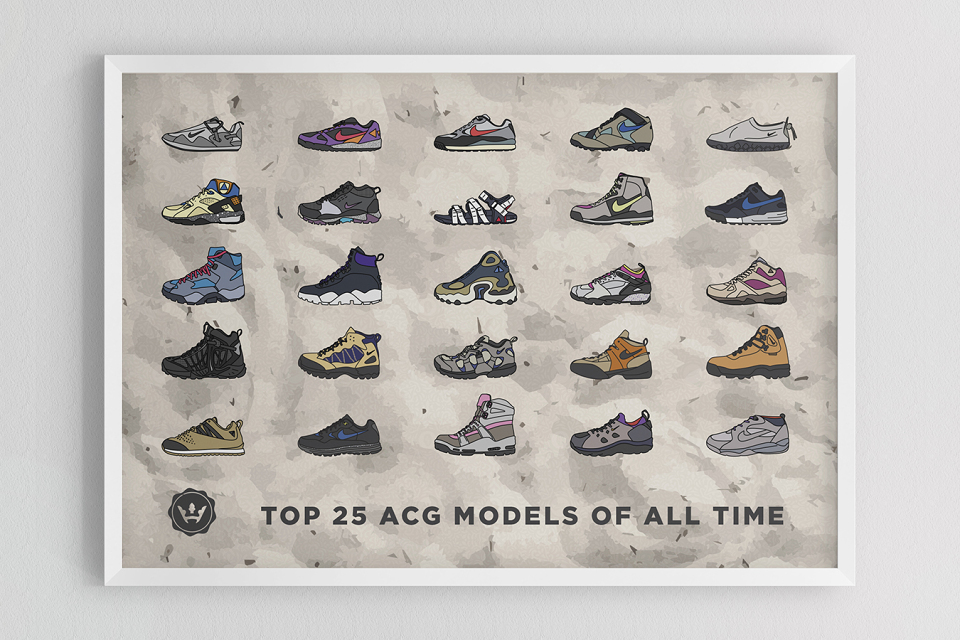
There’s something about Nike‘s All Conditions Gear line that fascinates me. It felt like a passion project for the company, with so many Nike designers and product people being into hiking and trail running, plus Nike’s Oregon location.
It’s a brand within a brand that seems to cause the same dewy-eyed reaction as classic Patagonia, The North Face and Polo Sport does with folks of a certain age. Even for those of us who have no intention of going beyond the beaten path in a pair of Wildwoods, those beige boxes, that triangular triple-letter ACG branding and the way the shoes were embraced by Tokyo’s early adopters, New York rap legends and a new breed of skaters back when jeans were at their most voluminous gives them a certain immortality. It seems weatherproof to the current levels of footwear hype too, because most folks who want Instagram likes through footwear probably won’t get them through bizarre, rustic-looking, neutral colored moments in decades old deadstock.
ACG was – and still is – a place where Nike’s greatest designers could go wild and make products for some extreme situations. Picking 25 of the best shoes is tough. It has to omit pre-1988 (the ACG name debuted in 1988 and the line really seemed to get its real launch in 1989) shoes, even though you could argue that the Lava Dome’s rerelease around 1998 under ACG makes that 1982 shoe qualify. It also has to omit non-ACG Terra designs too (which are some of the finest Nike releases ever) – in fact, I’d happily try to throw together a list of 25 great moments in Terra, though I’m sure I’d start struggling after 12.
There are at least 50 great ACG shoes. Here are just a few of them…
Nike Air Mowabb (1991)
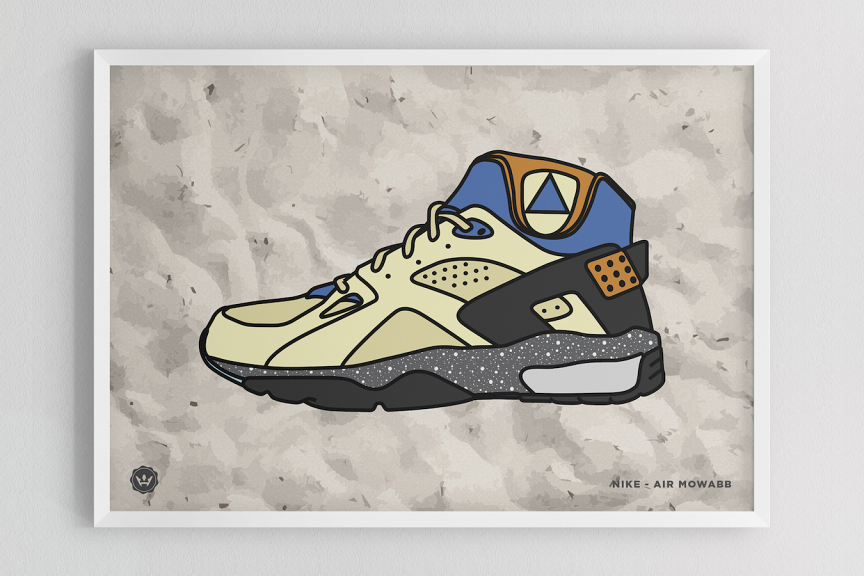 The Air Mowabb is a masterpiece. Created as a kind of outdoor cross training shoe for mountain biking, running and a spot of trekking, Tinker Hatfield took his own love of the outdoors to the sketch pad and created this classic. The Dynamic-Fit style collar kept debris, mud and stones out but made the shoe comfortable and the original speckle pattern was inspired by rainbow trout in the rivers and streams. That colorway alone, influenced by the colors of the outdoors and outdoor apparel of the time, was pioneering in its oddness and got plenty of play on other shoes a decade after this dropped.
The Air Mowabb is a masterpiece. Created as a kind of outdoor cross training shoe for mountain biking, running and a spot of trekking, Tinker Hatfield took his own love of the outdoors to the sketch pad and created this classic. The Dynamic-Fit style collar kept debris, mud and stones out but made the shoe comfortable and the original speckle pattern was inspired by rainbow trout in the rivers and streams. That colorway alone, influenced by the colors of the outdoors and outdoor apparel of the time, was pioneering in its oddness and got plenty of play on other shoes a decade after this dropped.
Foot Locker deserve a shout for getting there early with their SMU of the Air Max 93 that made good use of that snug collar concept. The Mowabb name is a reference to Utah’s (riffed on with the the Air Yewtah) trail-laden city of Moab. Early sketches of the shoe indicate that Tinker was playing with some Pendleton influence, too, to this progressive design, but that seemed to be ditched. A follow up was created via Steve McDonald and later versions would have some colorways that were equally as influential. To this day, the early 2002 update remains something of a mystery. Was that remake supposed to be an anniversary celebration of some sort? This shoe is perfection.
Nike Air Wildwood (1989)
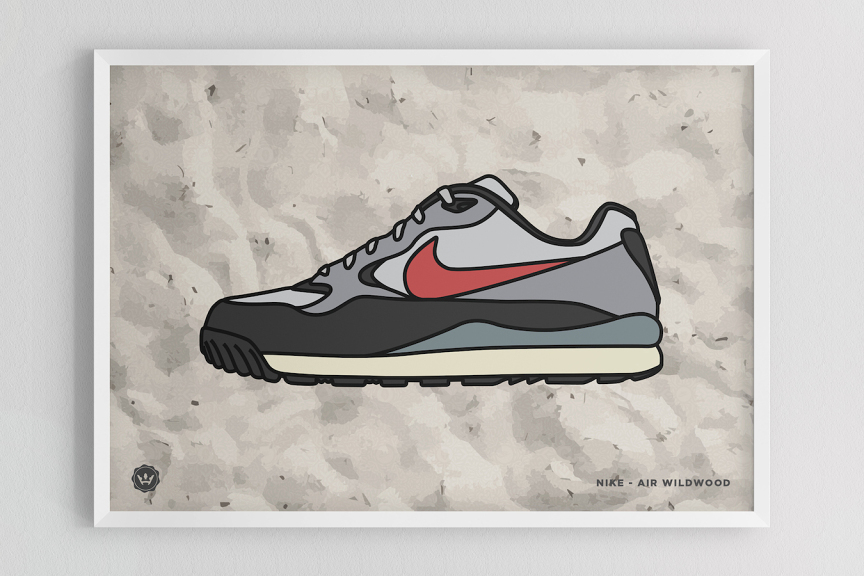 If the Air Pegasus was an OG ACG shoe, the Wildwood set the standard for trail runners that followed. This model was actually built to match the Pegasus design, but the bellowed tongue, Air-Sole, variable width lacing, that newly introduced lettering on the midsole, all synthetic perforated upper, and PU FootFrame midsole gave it its own identity. The use of a colored Swoosh to counteract murky colors was a smart move and this would get a retro a decade later that brought some new colors (that Fiberops edition was superb) – but there was always the curse of peeling paint jobs. Still, very little beats this shoe’s shape, fit and versatile style.
If the Air Pegasus was an OG ACG shoe, the Wildwood set the standard for trail runners that followed. This model was actually built to match the Pegasus design, but the bellowed tongue, Air-Sole, variable width lacing, that newly introduced lettering on the midsole, all synthetic perforated upper, and PU FootFrame midsole gave it its own identity. The use of a colored Swoosh to counteract murky colors was a smart move and this would get a retro a decade later that brought some new colors (that Fiberops edition was superb) – but there was always the curse of peeling paint jobs. Still, very little beats this shoe’s shape, fit and versatile style.
Nike Air Terra ACG (1991)
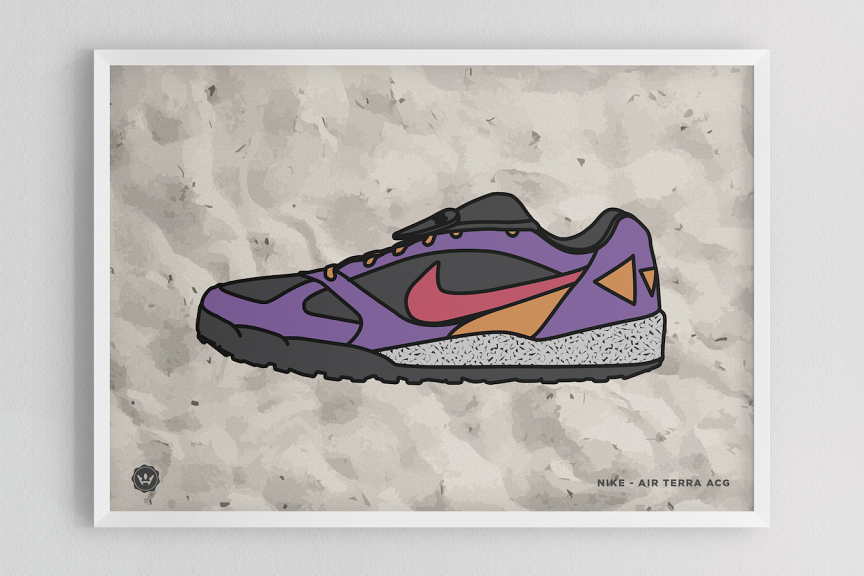 The Terra line as a lightweight distance running line dates back to around 1980. The Air Terra ACG was a brutal looking trail runner with some curiously flamboyant touches. A Lycra gusset tongue, lace cover, TV static style speckles on the midsole, a deflector shield and Phylon heel counter and multi-directional tyre style sole were the core components of Trip Allen’s creation. But it was the orange, pink and purple of the most popular version of this shoe which made it a thing of functional beauty. Never retroed, but sort of resurrected as the Terra ACG Long Ball in 2007, on the right feet, the original shoe looks incredible.
The Terra line as a lightweight distance running line dates back to around 1980. The Air Terra ACG was a brutal looking trail runner with some curiously flamboyant touches. A Lycra gusset tongue, lace cover, TV static style speckles on the midsole, a deflector shield and Phylon heel counter and multi-directional tyre style sole were the core components of Trip Allen’s creation. But it was the orange, pink and purple of the most popular version of this shoe which made it a thing of functional beauty. Never retroed, but sort of resurrected as the Terra ACG Long Ball in 2007, on the right feet, the original shoe looks incredible.
Nike Baltoro High (1990)
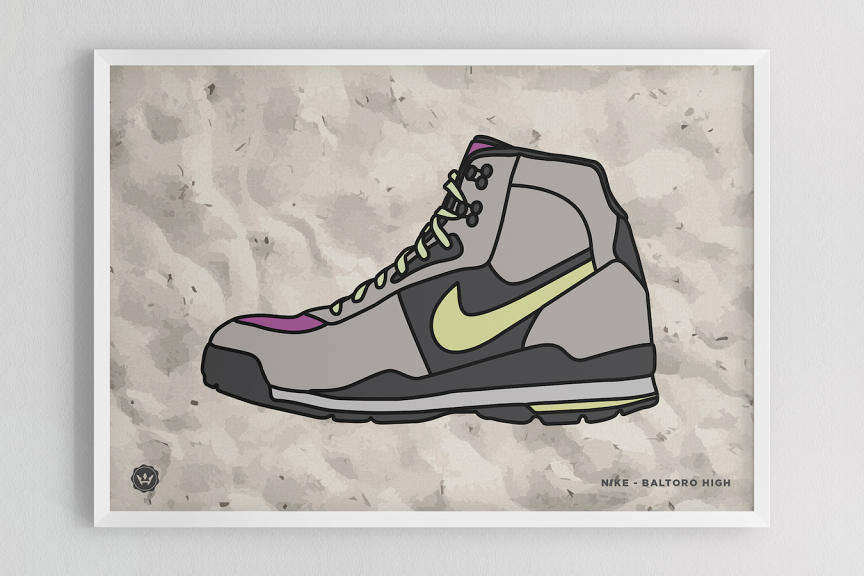 Beloved of both trekkers and the occasional New Jack Swing act coordinating their footwear, the Baltoro is a classic. A better looking boot than, say, the Lava High, the lighter feel (it was never built for hardcore hiking), dual density midsole, FootFrame, steel shank and waxed leather and mesh upper were all serious applications. The blue, pink and grey remains a fan favorite, but for the brave – and to coincide with some insane colors on jackets and other outerwear by brands like The North Face – the 1991 orange, teal, red and purple blend was the only way to go. The Baltoro was a breakthrough.
Beloved of both trekkers and the occasional New Jack Swing act coordinating their footwear, the Baltoro is a classic. A better looking boot than, say, the Lava High, the lighter feel (it was never built for hardcore hiking), dual density midsole, FootFrame, steel shank and waxed leather and mesh upper were all serious applications. The blue, pink and grey remains a fan favorite, but for the brave – and to coincide with some insane colors on jackets and other outerwear by brands like The North Face – the 1991 orange, teal, red and purple blend was the only way to go. The Baltoro was a breakthrough.
Nike Air Revaderchi (1992)
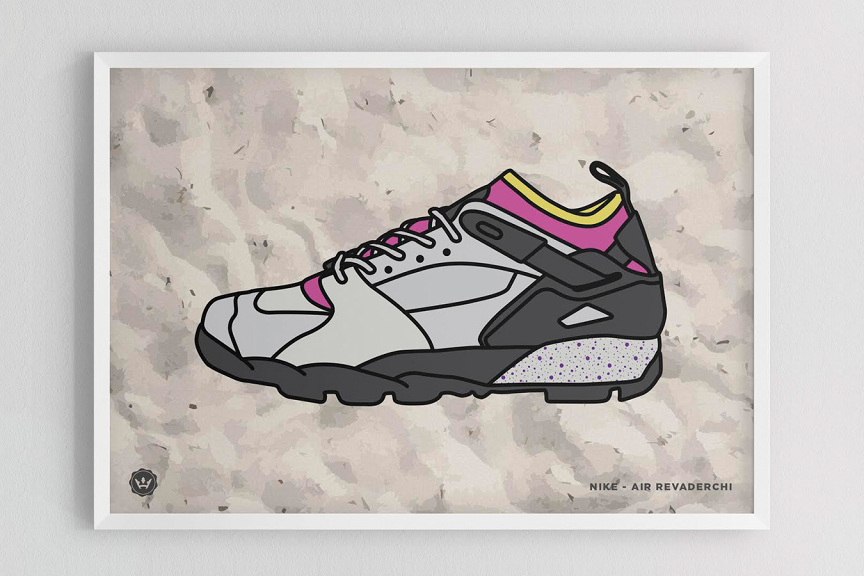 Huarache hits the trails. Truly one of the greatest names for a shoe ever. That alone warrants inclusion here, but Steve McDonald made this design live up to the cool name – the integrated toe for protection, mountain bike inspired rubber sole, ankle wrapping strap lacing and concealed plate to keep rocks from the foot led to a weird foot-conforming form with a Huarache neoprene fit. While it looked like it was only fit for its purpose, style masters like Grand Puba broke them out with a backpack, some Polo and Mary J Blige on support. The sequel that followed in 1993 was superb, too.
Huarache hits the trails. Truly one of the greatest names for a shoe ever. That alone warrants inclusion here, but Steve McDonald made this design live up to the cool name – the integrated toe for protection, mountain bike inspired rubber sole, ankle wrapping strap lacing and concealed plate to keep rocks from the foot led to a weird foot-conforming form with a Huarache neoprene fit. While it looked like it was only fit for its purpose, style masters like Grand Puba broke them out with a backpack, some Polo and Mary J Blige on support. The sequel that followed in 1993 was superb, too.
Nike ACG Lunar Wood “Wood Wood” (2009)
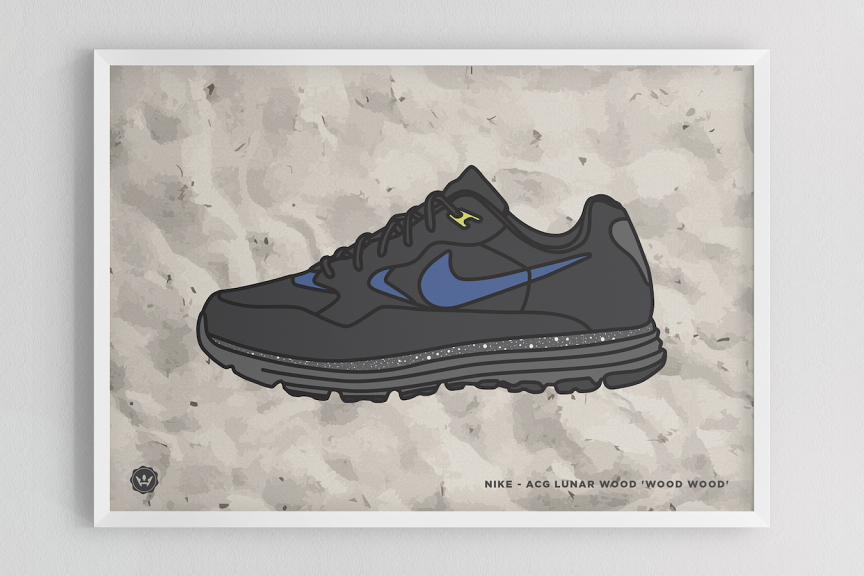 The Wildedge was an incredible update of the Wildwood DNA, but this edges it out of the top 25. The non Wood Wood editions don’t count, but these are classic – one of the best collaborations of the last ten years. Graffiti shoe concepts are generally abysmal (Futura, Stash and 12oz Prophet projects were exceptions), but this model took the idea and gave it an authenticity that didn’t need to resort to laser-embossed tags or lame throw-up graphics. Themed on late-night graffiti missions and the connection between ACG and that culture, the branding on this design, the introduction of a completely new silhouette and some special packaging on a small run of this TZ drop was flawless.
The Wildedge was an incredible update of the Wildwood DNA, but this edges it out of the top 25. The non Wood Wood editions don’t count, but these are classic – one of the best collaborations of the last ten years. Graffiti shoe concepts are generally abysmal (Futura, Stash and 12oz Prophet projects were exceptions), but this model took the idea and gave it an authenticity that didn’t need to resort to laser-embossed tags or lame throw-up graphics. Themed on late-night graffiti missions and the connection between ACG and that culture, the branding on this design, the introduction of a completely new silhouette and some special packaging on a small run of this TZ drop was flawless.
Nike Air Pegasus ACG (1988)
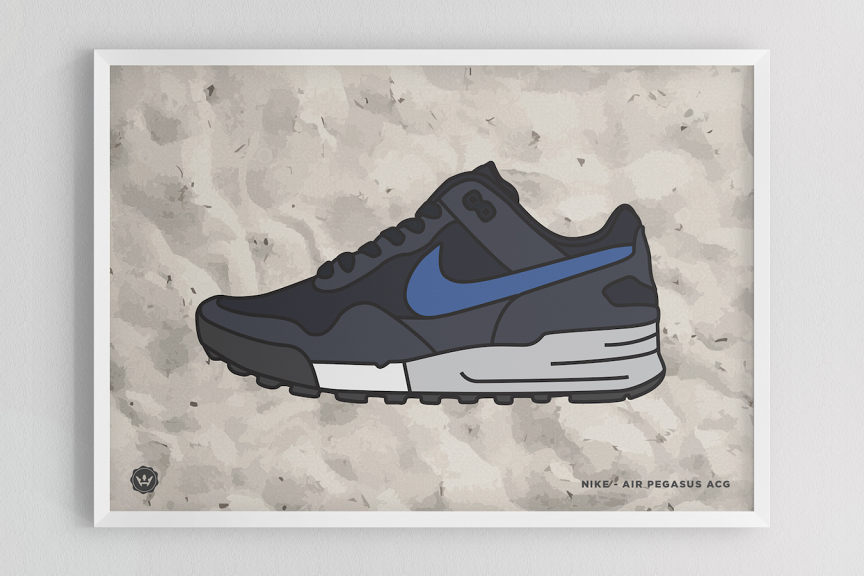 The original ACG shoe was an update on the bestselling Pegasus line that was sold alongside the All Conditions Gear GORE-TEX suit. The Escape-style wrapped rubber sole with extra traction, hiker-style colors and resilient leather upper and 3M trim was made to be used in every kind of weather. ACG would become a more official proposition the following year but this was the foundation for the legendary Wildwood. Bizarrely, you can also see these on Gene Wilder’s feet in the wildly un-PC comedy, See No Evil, Hear No Evil.
The original ACG shoe was an update on the bestselling Pegasus line that was sold alongside the All Conditions Gear GORE-TEX suit. The Escape-style wrapped rubber sole with extra traction, hiker-style colors and resilient leather upper and 3M trim was made to be used in every kind of weather. ACG would become a more official proposition the following year but this was the foundation for the legendary Wildwood. Bizarrely, you can also see these on Gene Wilder’s feet in the wildly un-PC comedy, See No Evil, Hear No Evil.
Nike Air Mada (1994)
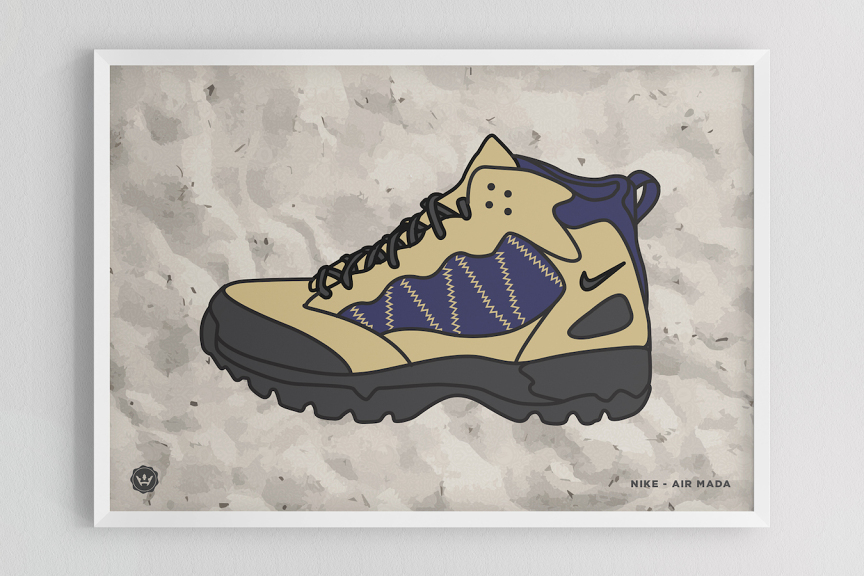 Much like the Yewtah, the Nike Air Mada was made for the mid-priced audience – a takedown of the design language that Tinker and co had given ACG by AM95 and Pocketknife designer Sergio Lozano. But, as anyone who studied the industry knows, the dollars are in mid-priced shoes like the Monarch and the brilliantly-named Air Mada blew up beyond the dads doing the mowing (interestingly, the Air Escape II would use a strange mowing man logo on the outsole) and became a classic. Whether it’s the canvas editions or the classic suedes or a plethora of sequels, or on Jerry Seinfeld’s feet, this is one of the greats.
Much like the Yewtah, the Nike Air Mada was made for the mid-priced audience – a takedown of the design language that Tinker and co had given ACG by AM95 and Pocketknife designer Sergio Lozano. But, as anyone who studied the industry knows, the dollars are in mid-priced shoes like the Monarch and the brilliantly-named Air Mada blew up beyond the dads doing the mowing (interestingly, the Air Escape II would use a strange mowing man logo on the outsole) and became a classic. Whether it’s the canvas editions or the classic suedes or a plethora of sequels, or on Jerry Seinfeld’s feet, this is one of the greats.
Nike Air Terra Tor (1996)
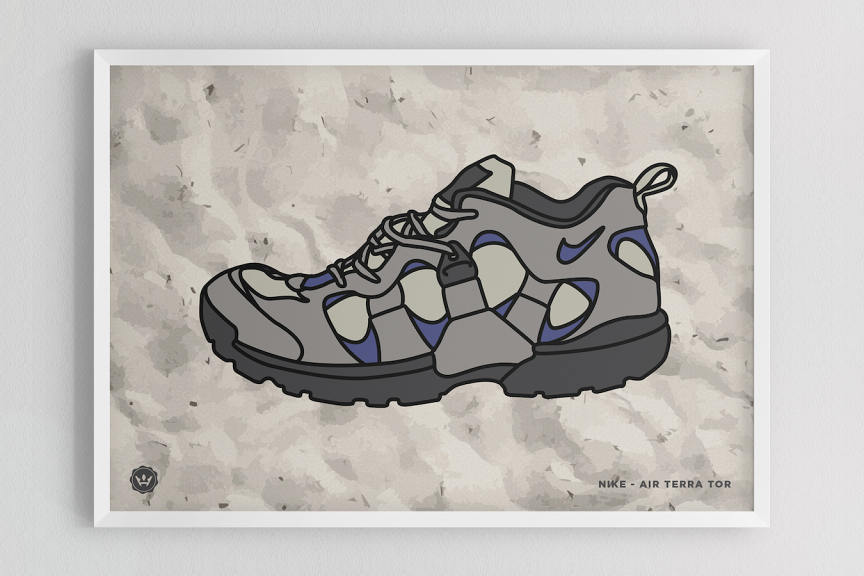 It’s a given that if you write about ACG, someone’s going to ask about the lack of Terra Albis, Terra Sertig, Terra Humara and Air Minot. Those things were some of the best shoes ever made, but they weren’t ACG – that whole Terra concept seemed to be a trail-running spinoff around 1996/1997 – while ACG seemed to become more hiking and watersport based.
It’s a given that if you write about ACG, someone’s going to ask about the lack of Terra Albis, Terra Sertig, Terra Humara and Air Minot. Those things were some of the best shoes ever made, but they weren’t ACG – that whole Terra concept seemed to be a trail-running spinoff around 1996/1997 – while ACG seemed to become more hiking and watersport based.
Confused? Just in case you weren’t, the recent Air Max Minot remix seemed to be sold as an ACG shoe. Anyway, the Air Terra Tor from 1996 seems to be the moment that somebody at Nike realized that Terra could be its own thing. This trail-running design had the classic purple and grey palette with the orange hits, the support strap system to stabilize the foot and a light and flexible feel. Slap, Big Brother, Transworld and Thrasher readers might recall occasionally seeing shoes like this on the feet of future legends at spots like Pier 7 in San Francisco around the time of their release.
Nike Air Moc (1994)
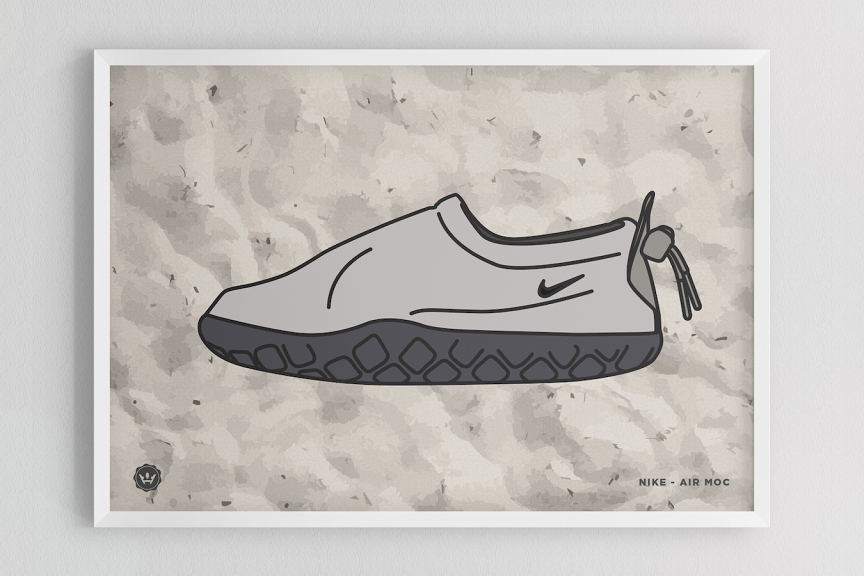 Those spud-like looks on this design aren’t a coincidence – this shoe was built for a comfortable, warm wear at camp and the perforations were inspired by fork marks in a baked potato. The original name was the Air Ida – a play on the Ore-Ida potato company – but legal concerns led to a name change. The cord fastening, internal heel counter and full-length Air-Sole made it incredibly effective, despite the freaky looks. Huge in Japan, chukka versions appeared, special camouflage versions dropped in the late 1990s, nylon takes and some sequels too. A special mid-cut edition of the Moc would be part of the original HTM collection in 2002. A cult classic.
Those spud-like looks on this design aren’t a coincidence – this shoe was built for a comfortable, warm wear at camp and the perforations were inspired by fork marks in a baked potato. The original name was the Air Ida – a play on the Ore-Ida potato company – but legal concerns led to a name change. The cord fastening, internal heel counter and full-length Air-Sole made it incredibly effective, despite the freaky looks. Huge in Japan, chukka versions appeared, special camouflage versions dropped in the late 1990s, nylon takes and some sequels too. A special mid-cut edition of the Moc would be part of the original HTM collection in 2002. A cult classic.
Nike Air Okwahn (1998)
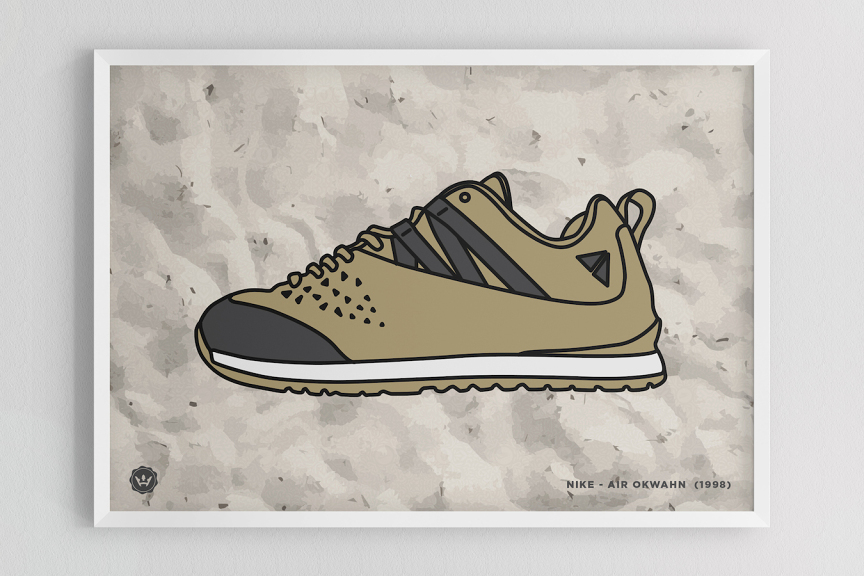 The Okwahn was a popular shoe back in the late 1990s in Japan and went though a number of strong makeups between 1998 and 2002. Made to be resoled and incredibly lightweight, these were created with the mysterious terrasport approach to performance in mind and meant to be worn in a rock-based environment. It’s odd that despite that purpose, these things were incredibly slippery in an urban environment when things got wet or icy. Nate VanHook’s Okwahn II design from a couple of years back improved on any prior issues and was one of the best shoe sequels in a long, long time.
The Okwahn was a popular shoe back in the late 1990s in Japan and went though a number of strong makeups between 1998 and 2002. Made to be resoled and incredibly lightweight, these were created with the mysterious terrasport approach to performance in mind and meant to be worn in a rock-based environment. It’s odd that despite that purpose, these things were incredibly slippery in an urban environment when things got wet or icy. Nate VanHook’s Okwahn II design from a couple of years back improved on any prior issues and was one of the best shoe sequels in a long, long time.
Nike Air Azona 2 (1993)
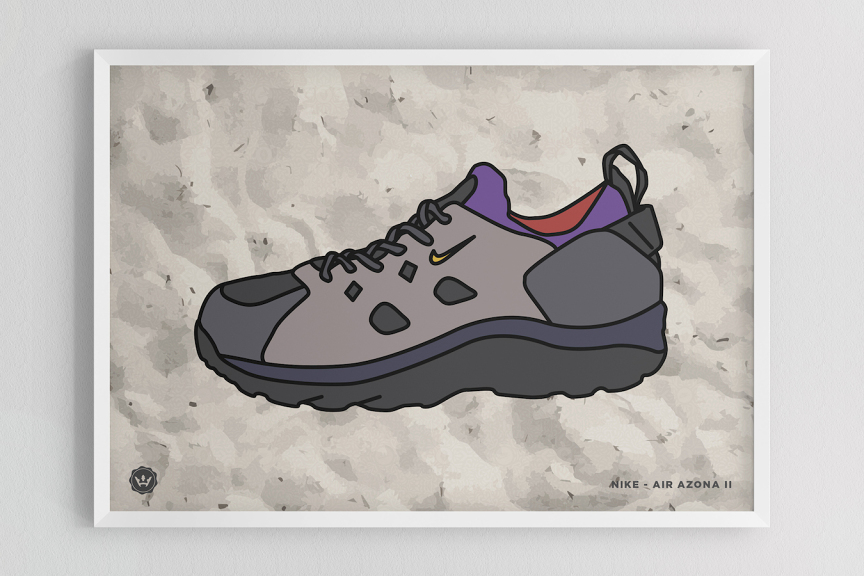 The Nike Air Azona represented a state, like the Yewtah did when it came to its name, but was a more expensive, technical proposition. Made for high performance, the Dynamic-Fit inner boot and rubber toe increased comfort and traction, while the rails on the outsole were tweaked for easy entry and exit into a pedal. The original edition had some low-cut Mowabb in its design, but the 1993 sequel brought the Air Azona design even more of its own identity. This was several shoes in one.
The Nike Air Azona represented a state, like the Yewtah did when it came to its name, but was a more expensive, technical proposition. Made for high performance, the Dynamic-Fit inner boot and rubber toe increased comfort and traction, while the rails on the outsole were tweaked for easy entry and exit into a pedal. The original edition had some low-cut Mowabb in its design, but the 1993 sequel brought the Air Azona design even more of its own identity. This was several shoes in one.
Nike Pocket Knife (1998)
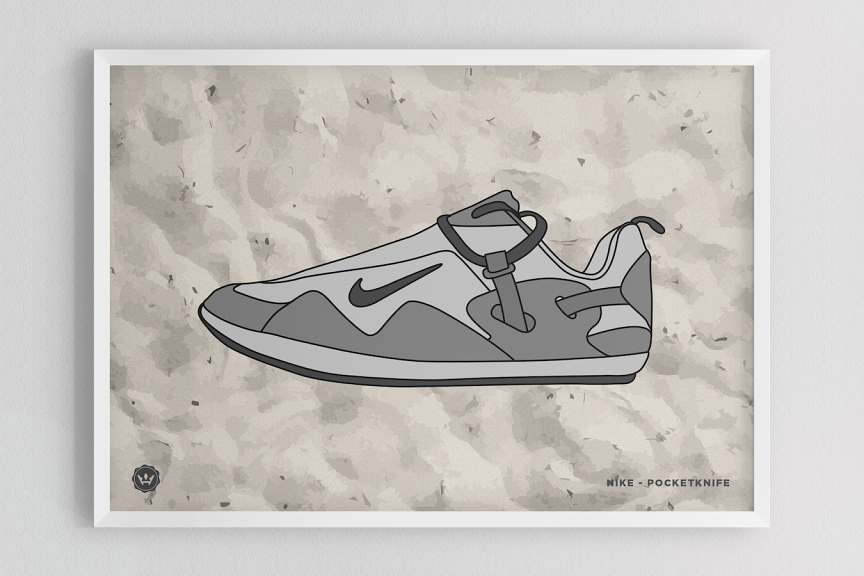 The Nike Pocket Knife was a curious shoe, with that throwback runner look betraying the innovation behind it — minimal and light, this was created to be thrown in a rucksack and be worn at base camp. Bear in mind that ACG – and Nike’s entire outdoors line – was supposedly spawned by John Roskelley and friends at base camp in Nike’s distance running shoes and this feels like a tribute. Sergio Lozano was the designer behind these shoes and, with their lack of heel counter, they were created to be folded. Nike gave the design some great patterned colorways and they became a cult favorite at trend level back in 1998, even though they fitted super medium if you had wider feet. Oft imitated in the late 1990s and never bettered.
The Nike Pocket Knife was a curious shoe, with that throwback runner look betraying the innovation behind it — minimal and light, this was created to be thrown in a rucksack and be worn at base camp. Bear in mind that ACG – and Nike’s entire outdoors line – was supposedly spawned by John Roskelley and friends at base camp in Nike’s distance running shoes and this feels like a tribute. Sergio Lozano was the designer behind these shoes and, with their lack of heel counter, they were created to be folded. Nike gave the design some great patterned colorways and they became a cult favorite at trend level back in 1998, even though they fitted super medium if you had wider feet. Oft imitated in the late 1990s and never bettered.
Some connoisseurs of weirdo shoes might recall the City Knife from a few years later that had the origami-style approach to folding. In the UK, a media fear over escalating knife crime a while ago led to a pointless outcry over the Air Stab – these would probably have cause a commotion if they’d been popular at that point too.
Nike Zoom Tallac (2003)
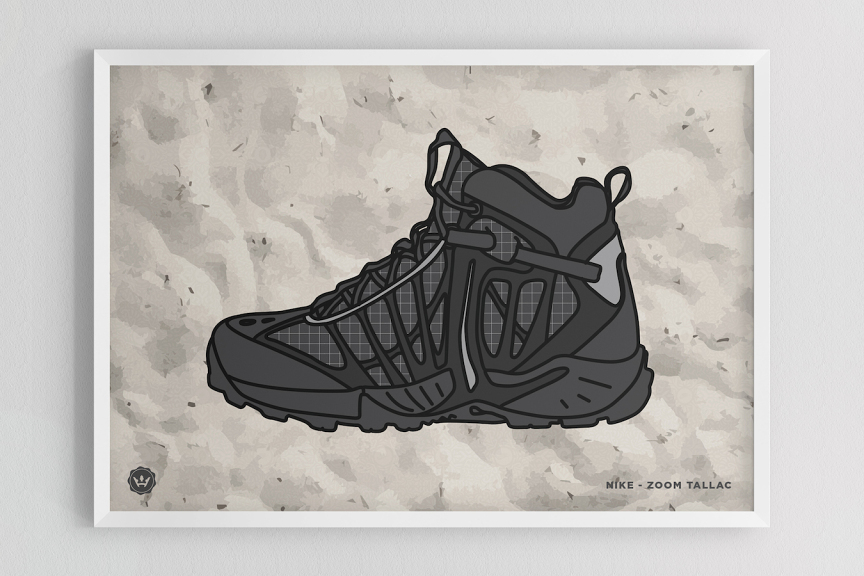 As it hit its 20th birthday in 2008, the ACG category seemed to come to a close as a place for pure performance – more and more Nike Sportswear releases bore the triangle but were purely lifestyle based. A few years prior, it was still going strong – the Zoom Tallac came from the mind of genius designer Peter Fogg (the mastermind behind the Terra Humara and Air Minot) and looked like nothing else on the market. Super light, GORE-TEX assisted, boasting a TPU exoskeleton and carrying the always-effective Zoom Air system, this seemed to be a sequel to the Air Talus (the name and that mid foot shank indicate that was the case anyway) and was an example of totally progressive design in a fairly patchy period when it came to future classics. Those that know, know.
As it hit its 20th birthday in 2008, the ACG category seemed to come to a close as a place for pure performance – more and more Nike Sportswear releases bore the triangle but were purely lifestyle based. A few years prior, it was still going strong – the Zoom Tallac came from the mind of genius designer Peter Fogg (the mastermind behind the Terra Humara and Air Minot) and looked like nothing else on the market. Super light, GORE-TEX assisted, boasting a TPU exoskeleton and carrying the always-effective Zoom Air system, this seemed to be a sequel to the Air Talus (the name and that mid foot shank indicate that was the case anyway) and was an example of totally progressive design in a fairly patchy period when it came to future classics. Those that know, know.
Nike Air Superdome (1991)
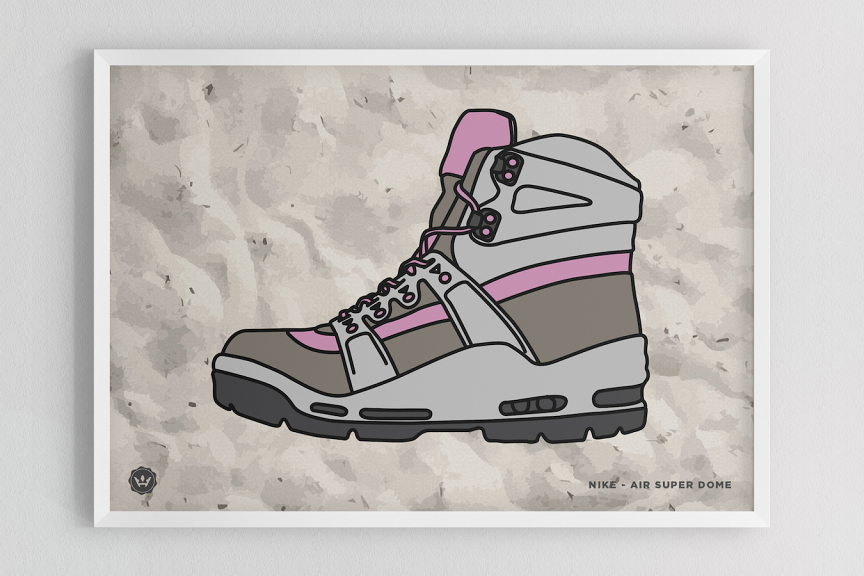 Costing $225 USD in 1991, the Nike Air Superdome was an incredibly expensive shoe. People moan about prices in 2014, but that price tag 23 years ago seemed insane. Still, you got a lot of shoe for your money – full length Nike Air, a GORE-TEX lining, support straps, that caged feel, total waterproofing, vast protective midsole, a Baltoro on steroids look (down to the colors) and what seemed like the logical conclusion to the Lava Dome concept in terms of the size of them. Of course, the early 2000s Goadome boot would be a more popular way to get ‘dome several years later, but that one was made to capitalize on the inner-city love of Timberlands rather than trail use, whereas the Superdome was made for extreme off-road conditions. The Superdome got an unexpected retro in 2007 with a Goadome-style sole unit.
Costing $225 USD in 1991, the Nike Air Superdome was an incredibly expensive shoe. People moan about prices in 2014, but that price tag 23 years ago seemed insane. Still, you got a lot of shoe for your money – full length Nike Air, a GORE-TEX lining, support straps, that caged feel, total waterproofing, vast protective midsole, a Baltoro on steroids look (down to the colors) and what seemed like the logical conclusion to the Lava Dome concept in terms of the size of them. Of course, the early 2000s Goadome boot would be a more popular way to get ‘dome several years later, but that one was made to capitalize on the inner-city love of Timberlands rather than trail use, whereas the Superdome was made for extreme off-road conditions. The Superdome got an unexpected retro in 2007 with a Goadome-style sole unit.
Nike Air Deschutz (1992)
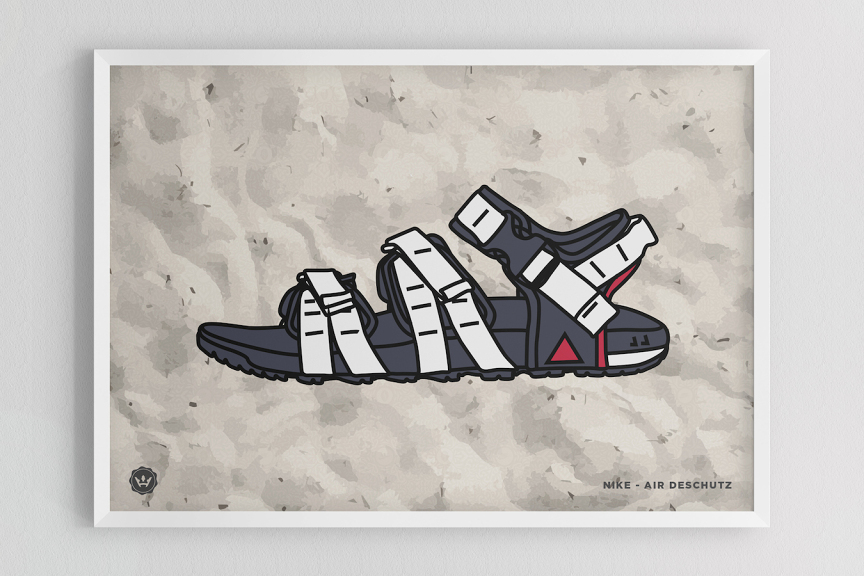 Nike reinvented the Jesus sandal with this one. Preempted by a campaign that showed a hiking boot hacked apart to reveal these inside, this Steve McDonald design was one of ACG’s success stories. Nike-Air, a Phylon sole, rear and forefoot straps and high-traction properties made them an athletic shoe without the shoe and the lettering on the outsole was excellent. Sold for water sports, climbing and running outdoors, there were a ton of sequels, plus Pro editions that were big in Japan, where the changeable, humid weather can necessitate something like the Deschutz. The fairly recent SOPHNET editions indicated that there’s still a place for this design overseas.
Nike reinvented the Jesus sandal with this one. Preempted by a campaign that showed a hiking boot hacked apart to reveal these inside, this Steve McDonald design was one of ACG’s success stories. Nike-Air, a Phylon sole, rear and forefoot straps and high-traction properties made them an athletic shoe without the shoe and the lettering on the outsole was excellent. Sold for water sports, climbing and running outdoors, there were a ton of sequels, plus Pro editions that were big in Japan, where the changeable, humid weather can necessitate something like the Deschutz. The fairly recent SOPHNET editions indicated that there’s still a place for this design overseas.
Nike Air Lava Dome 2000 (1996)
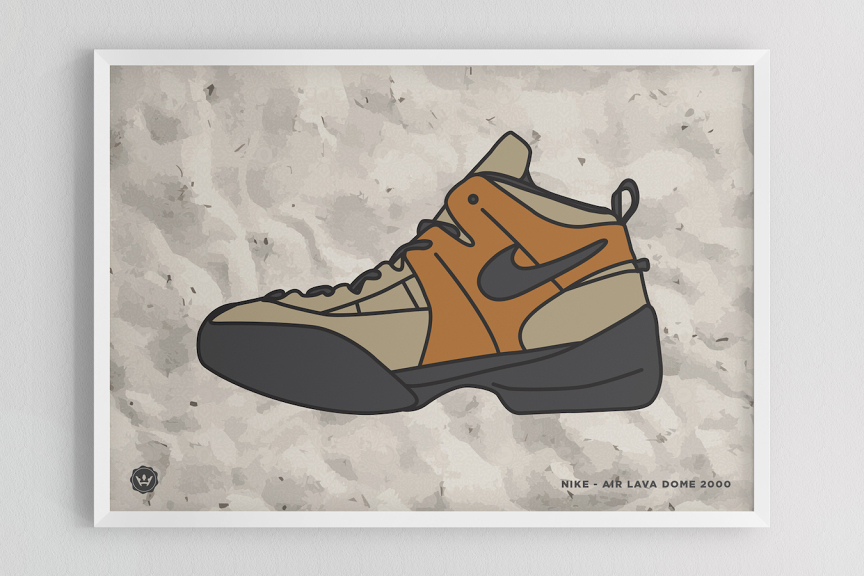 If we’re talking strictly ACG (All Conditions Gear debuted in 1988), then the original 1982-era Lava Dome (one of the best Nike shoes ever is omitted) and the Son of Lava Dome don’t necessarily qualify for inclusion here. Despite the name, the Air Lava Dome 2000 is from 1996. The looks are kind of a grower (the OG Lava Dome is a better looking design), but there’s a lot of interesting stuff at work in this design too – the Approach lettering on the tongue seems like a reference to the Nike Approach that dropped at the same time as the Lava Dome back in the day and the craziest aspect of this one was the way the sticky rubber sole sticks to surfaces – it has that cinema floor feel whenever you’re indoors. These were pitched in the same ad campaign that pushed the Jason Kidds, Jordan XIs, Air Max 95s and a handful of other classics.
If we’re talking strictly ACG (All Conditions Gear debuted in 1988), then the original 1982-era Lava Dome (one of the best Nike shoes ever is omitted) and the Son of Lava Dome don’t necessarily qualify for inclusion here. Despite the name, the Air Lava Dome 2000 is from 1996. The looks are kind of a grower (the OG Lava Dome is a better looking design), but there’s a lot of interesting stuff at work in this design too – the Approach lettering on the tongue seems like a reference to the Nike Approach that dropped at the same time as the Lava Dome back in the day and the craziest aspect of this one was the way the sticky rubber sole sticks to surfaces – it has that cinema floor feel whenever you’re indoors. These were pitched in the same ad campaign that pushed the Jason Kidds, Jordan XIs, Air Max 95s and a handful of other classics.
Nike Air Talus (1996)
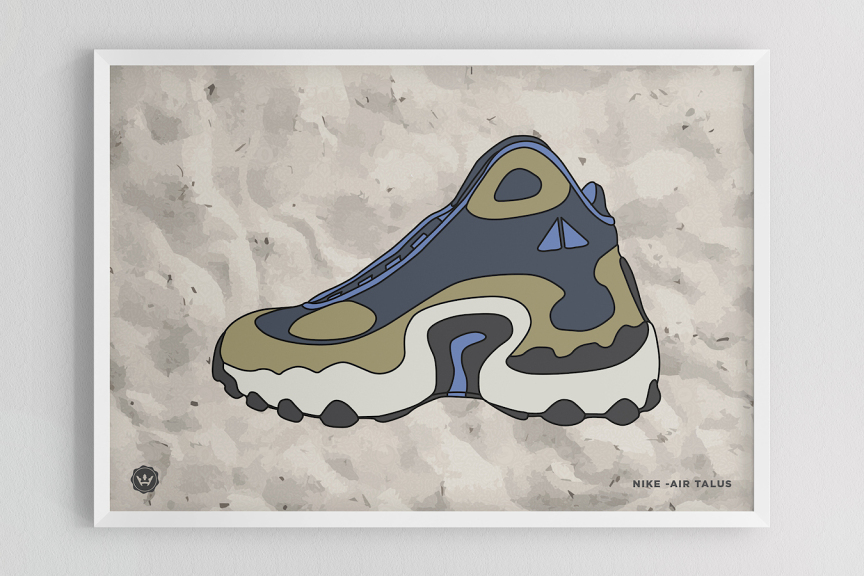 Ugly-beautiful applies to this one. The Air Talus looked more like a basketball shoe than a trail design and its low equivalent just seemed ugly-ugly, but this one made that midfoot shank the star much like the Zoom Challenge Agassi shoe, Zoom Turf Jet and Zoom Flight designs from around the same time. Despite that apparent bulk, these were made for hiking, trail running and biking – that same outdoor cross training thinking that birthed the Mowabb half a decade earlier. The more rugged Tumac from the following year couldn’t match these. If you like the Talus, you’re probably a Zoom Tallac appreciator too.
Ugly-beautiful applies to this one. The Air Talus looked more like a basketball shoe than a trail design and its low equivalent just seemed ugly-ugly, but this one made that midfoot shank the star much like the Zoom Challenge Agassi shoe, Zoom Turf Jet and Zoom Flight designs from around the same time. Despite that apparent bulk, these were made for hiking, trail running and biking – that same outdoor cross training thinking that birthed the Mowabb half a decade earlier. The more rugged Tumac from the following year couldn’t match these. If you like the Talus, you’re probably a Zoom Tallac appreciator too.
Nike Kibo High (1992)
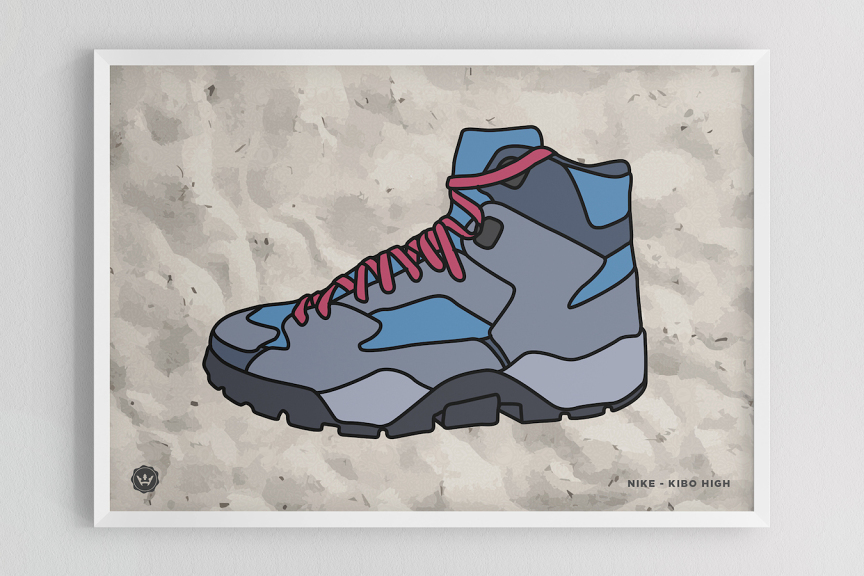 Things get a little confusing around this point, with some marketing materials placing these as a Nike Outdoors release rather than ACG. Before there was the Rhyolite, there was this equally obscure ACG monster that was built for every kind of terrain. Sold alongside the low-cut Lava Crest, the FootFrame technology on these shoes secured the foot and supported on uneven terrain. Steel shanks, tuck boards and insole boards, waxed leather, breathable mesh (but no Nike Air), plus some phenomenal Baltoro-style colors made these look ultra futuristic. That distinctive toe panel made these look very different indeed.
Things get a little confusing around this point, with some marketing materials placing these as a Nike Outdoors release rather than ACG. Before there was the Rhyolite, there was this equally obscure ACG monster that was built for every kind of terrain. Sold alongside the low-cut Lava Crest, the FootFrame technology on these shoes secured the foot and supported on uneven terrain. Steel shanks, tuck boards and insole boards, waxed leather, breathable mesh (but no Nike Air), plus some phenomenal Baltoro-style colors made these look ultra futuristic. That distinctive toe panel made these look very different indeed.
Nike Air Escape (1992)
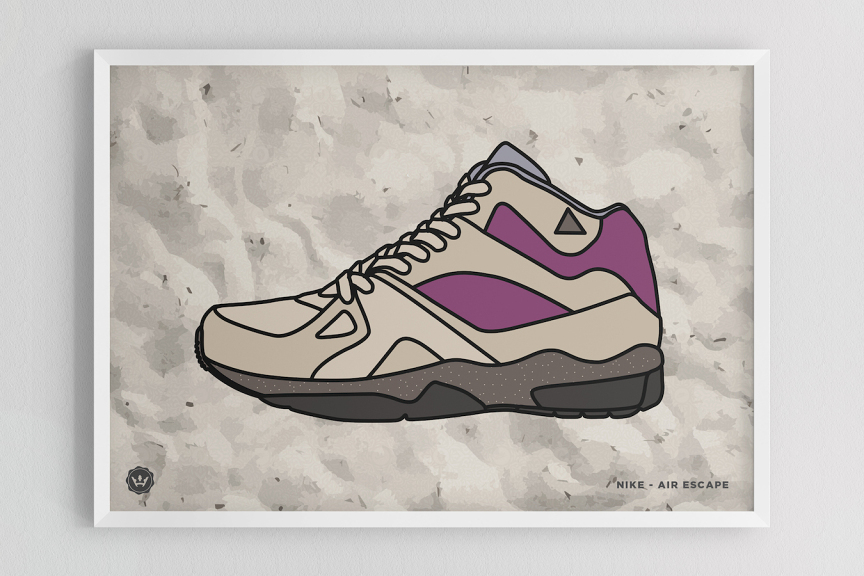 In high or low forms, the original Air Escape was a good example of the ACG line’s golden age. Looking more than a little like a Mowabb with that shape and speckling, this shoe picked up on the ideas that Mark Parker’s pioneering Nike Escape design from 1984 birthed, making it a belated followup that used some new tools. The colors that this dropped in – olives, purples, tans and grays – plus that subtle triangular ACG branding stay classic. There were a handful of sequels like the similar Escape II and the bizarre Escape II that looked like it had been dipped in molten Regrind rubber.
In high or low forms, the original Air Escape was a good example of the ACG line’s golden age. Looking more than a little like a Mowabb with that shape and speckling, this shoe picked up on the ideas that Mark Parker’s pioneering Nike Escape design from 1984 birthed, making it a belated followup that used some new tools. The colors that this dropped in – olives, purples, tans and grays – plus that subtle triangular ACG branding stay classic. There were a handful of sequels like the similar Escape II and the bizarre Escape II that looked like it had been dipped in molten Regrind rubber.
Nike Air Rhyolite (1994)
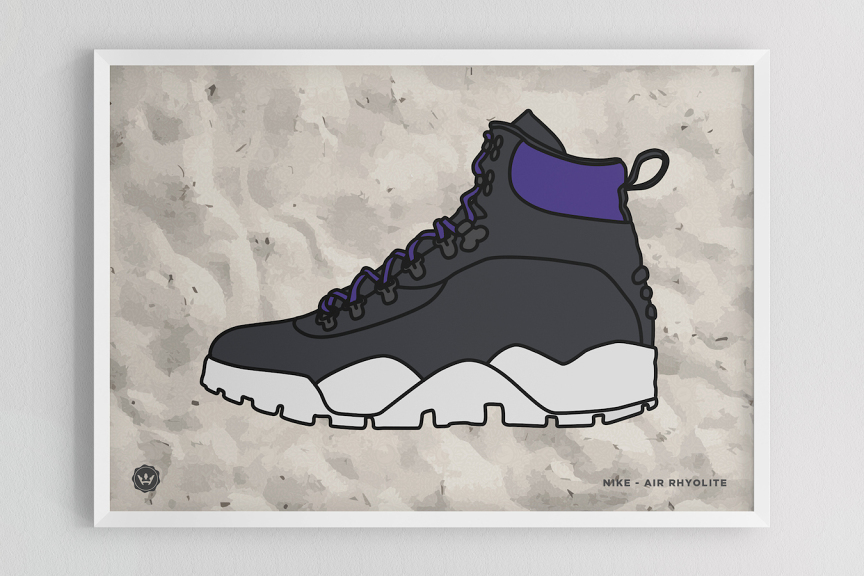 Short-lived greatness that might be one of the most brutal-looking ACG designs ever. The single-piece waterproof leather upper was meant to be weatherproof and the Cambrelle lining provided moisture wicking during hikes. The PU midsole was the star here visually, with a steel shank inside and forefoot flex grooves. That sole would end up on the more accessible Khyber II later in the year and the underrated Vulgarian Chukka in 1995, but the inclusion of the Rhyolite in 2007′s Tech Pack that preempted Nike Sportswear gave it the status it deserved.
Short-lived greatness that might be one of the most brutal-looking ACG designs ever. The single-piece waterproof leather upper was meant to be weatherproof and the Cambrelle lining provided moisture wicking during hikes. The PU midsole was the star here visually, with a steel shank inside and forefoot flex grooves. That sole would end up on the more accessible Khyber II later in the year and the underrated Vulgarian Chukka in 1995, but the inclusion of the Rhyolite in 2007′s Tech Pack that preempted Nike Sportswear gave it the status it deserved.
Nike Air Yewtah (1992)
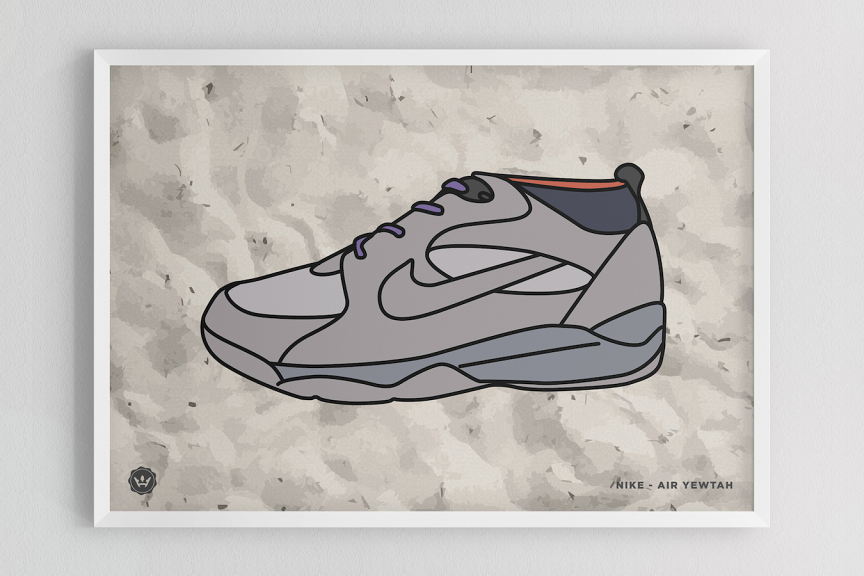 Somebody really went in with the names in 1992. The Yewtah’s name played on the state that houses the city of Moab, drawing a connection between the Mowabb and this newer design. Never a top-tier release, the neoprene/spandex collar on these and choice of colors for male and females made these memorable. Even the budget ACG shoes from this period were better than most trail shoes that followed. The similar Yewtah II design followed a couple of years later.
Somebody really went in with the names in 1992. The Yewtah’s name played on the state that houses the city of Moab, drawing a connection between the Mowabb and this newer design. Never a top-tier release, the neoprene/spandex collar on these and choice of colors for male and females made these memorable. Even the budget ACG shoes from this period were better than most trail shoes that followed. The similar Yewtah II design followed a couple of years later.
Nike Air Tarn (1995)
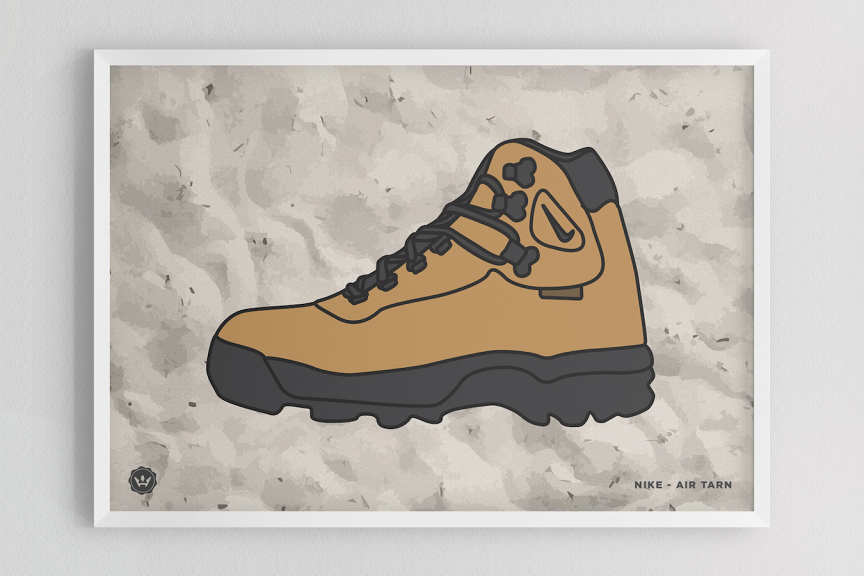 The Nike ACG line included a solid selection of lightweight and more heavyweight hikers, but the Air Tarn was one of the most premium offerings of the mid 1990s. Feeling like the lovechild of 1982′s Approach – the original Nike GORE-TEX shoe – the GORE-TEX drop sock lining, gusseted tongue, waterproof leather, heel Nike Air, cool-sounding thermoplastic tuning fork shank and durable feel made this one a strong response to other shoes on the market. The use of the Swoosh branding on the sole and upper makes this memorable. They had a lower break in time than a pair of Timbs too.
The Nike ACG line included a solid selection of lightweight and more heavyweight hikers, but the Air Tarn was one of the most premium offerings of the mid 1990s. Feeling like the lovechild of 1982′s Approach – the original Nike GORE-TEX shoe – the GORE-TEX drop sock lining, gusseted tongue, waterproof leather, heel Nike Air, cool-sounding thermoplastic tuning fork shank and durable feel made this one a strong response to other shoes on the market. The use of the Swoosh branding on the sole and upper makes this memorable. They had a lower break in time than a pair of Timbs too.
Nike ACG Salbis GTX (2009)
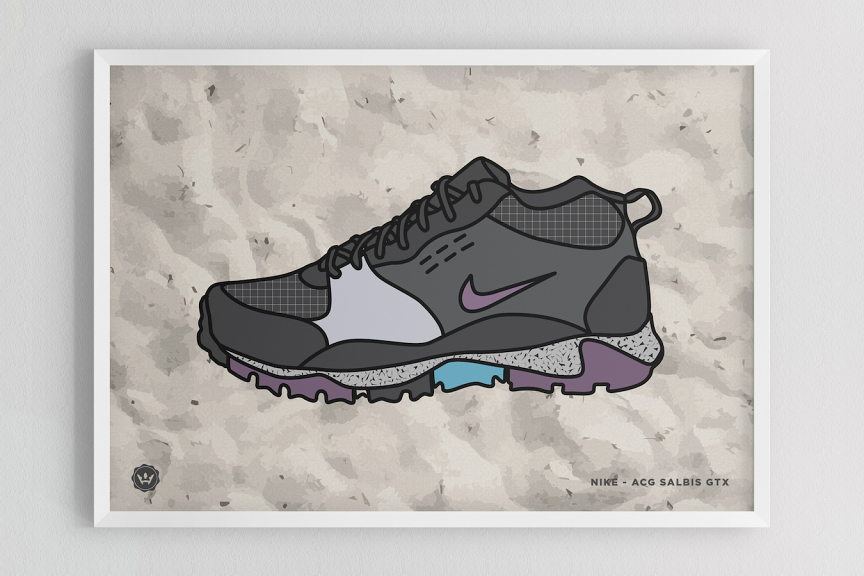 A complete cheat of an inclusion, because it was never actually released, the Nike ACG Salbis GTX was incredible – the samples were a flawless mix of Terra DNA and modern ACG (continuing the confusing ACG and Terra crossover, the name and look of this shoe is a play on the non-ACG Terra Albis) based on performance rucksacks and sealed seam technical jacket. That grid pattern and GORE-TEX lining and dense speckling, plus a TrailFrame sole? Phenomenal. Designer Michael Sarantakos’s Zoom Morizaba got a release and any tantrums over the Salbis getting canned were calmed a little by the release of the excellent Ashiko boot later that year.
A complete cheat of an inclusion, because it was never actually released, the Nike ACG Salbis GTX was incredible – the samples were a flawless mix of Terra DNA and modern ACG (continuing the confusing ACG and Terra crossover, the name and look of this shoe is a play on the non-ACG Terra Albis) based on performance rucksacks and sealed seam technical jacket. That grid pattern and GORE-TEX lining and dense speckling, plus a TrailFrame sole? Phenomenal. Designer Michael Sarantakos’s Zoom Morizaba got a release and any tantrums over the Salbis getting canned were calmed a little by the release of the excellent Ashiko boot later that year.
Nike Pooh-Bah (1993)
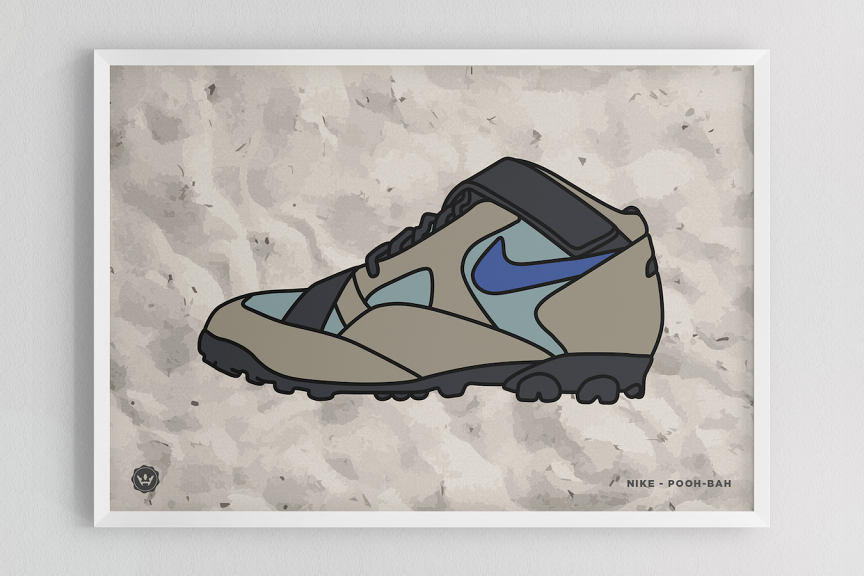 The name of this shoe has nothing to do with the rapper who put the Air Revaderchi on stage – it’s actually a cycling shoe – but it’s imbued with the best of the early 1990s ACG aesthetic. A pad on the outsole ripped away to reveal the C.O.R.P.S. Zone which was a plastic shank for some kind of pedal system. The shoe itself looked like some curious union of Raid and Nike hiker. There were a few strong All Conditions Gear mountain bike shoes, but this was one of the most memorable.
The name of this shoe has nothing to do with the rapper who put the Air Revaderchi on stage – it’s actually a cycling shoe – but it’s imbued with the best of the early 1990s ACG aesthetic. A pad on the outsole ripped away to reveal the C.O.R.P.S. Zone which was a plastic shank for some kind of pedal system. The shoe itself looked like some curious union of Raid and Nike hiker. There were a few strong All Conditions Gear mountain bike shoes, but this was one of the most memorable.
Text by Gary Warnett, Former Crooked Tongues, for Highsnobiety.com
Illustrations by Dan Freebairn of KickPosters.com







